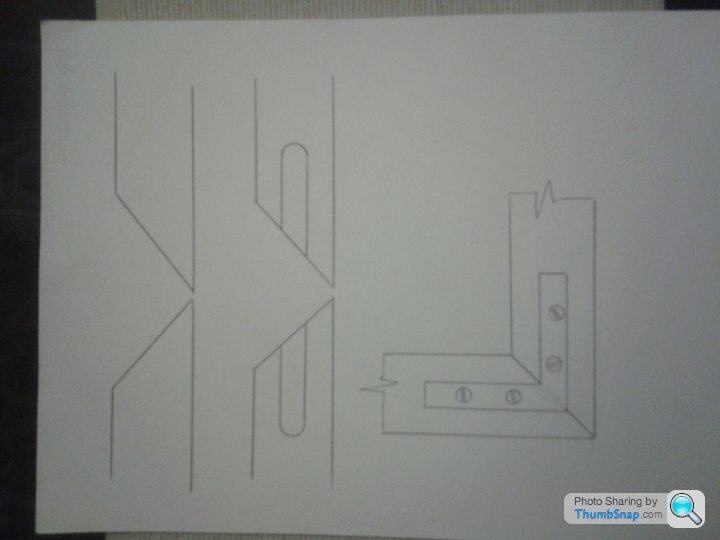How am I Joining These Here Sticks?
Discussion
I've made an oak frame to fill to the left of a chimney breast, it's where my boiler, alamr, server etc are housed, with a coat rail underneath and shoes below that.
Anyway, It's one large door at the top, two doors underneath, frame is all done, lap jointed where the door rebatest are and screwed together from the sides, so nothing visible.
I'm moving on to the doors and not sure how to go about putting them together. They're basically four bits of oak round the outside, with oak veneered MDF to fill the hole. The outer frame is roughly 35mm wide, 30mm deep, with a 10mm rebate to the rear to accept the MDF panels.
Initial thought is to lap joint the frames, but these could only be glued in the main, rather than screwed as well. The MDF will be glued and panel-pinned in place from behind, which would add a lot of strength I think. Will this be sufficient on a door of 1.5m x 1.5m? Smaller doors are 1.5m x 0.75m.
What are the best options for jointing, bearing in mind my access to accurate cutting equipment is limited to a router and a dowel jig.
Ta
Anyway, It's one large door at the top, two doors underneath, frame is all done, lap jointed where the door rebatest are and screwed together from the sides, so nothing visible.
I'm moving on to the doors and not sure how to go about putting them together. They're basically four bits of oak round the outside, with oak veneered MDF to fill the hole. The outer frame is roughly 35mm wide, 30mm deep, with a 10mm rebate to the rear to accept the MDF panels.
Initial thought is to lap joint the frames, but these could only be glued in the main, rather than screwed as well. The MDF will be glued and panel-pinned in place from behind, which would add a lot of strength I think. Will this be sufficient on a door of 1.5m x 1.5m? Smaller doors are 1.5m x 0.75m.
What are the best options for jointing, bearing in mind my access to accurate cutting equipment is limited to a router and a dowel jig.
Ta
Thanks, that’s useful. I did run the design past the sawmill chap, who is a very experienced joiner and cabinet maker and he thought it was OK. The wood is bought and rebated already, so I’m operating within that context. The rebate is to the rear, rather than in the middle as it allows a thinner door for the same external aesthetics. That may be a mistake from what you’ve said, but it’s done now.
Thinking about what lengths I cut the frame to, the top door is 1146mm wide and about 900mm tall. The lower two doors would be about 1500mm tall x half the width of the top door (as there’s two of them). So that’s a bit smaller than I originally suggested.
A cross brace could be added to the doors if necessary. Each door will be restrained on one side by the three hinges, these are the same hinges as I’ve used on the door, so will do a good job. I could look at catches top and bottom to restrain the other side of the door, which would minimise the impact of any movement.
I don’t have a lot to lose by seeing what happens with the wood I’ve got as I’m unlikely to find another use for it and it’ll take a bit of time to replace it with something else.
Keep the advice coming, it’s appreciated!
Thinking about what lengths I cut the frame to, the top door is 1146mm wide and about 900mm tall. The lower two doors would be about 1500mm tall x half the width of the top door (as there’s two of them). So that’s a bit smaller than I originally suggested.
A cross brace could be added to the doors if necessary. Each door will be restrained on one side by the three hinges, these are the same hinges as I’ve used on the door, so will do a good job. I could look at catches top and bottom to restrain the other side of the door, which would minimise the impact of any movement.
I don’t have a lot to lose by seeing what happens with the wood I’ve got as I’m unlikely to find another use for it and it’ll take a bit of time to replace it with something else.
Keep the advice coming, it’s appreciated!
I've made large frames in oak, a similar size to the sections you are using albeit with a perspex panel as a display case. To give the corners some strength I cut the 45 angles, laid the pieces next to each other in a straight line and routed a recess along both, so that they take a metal corner plate sat flush once put back at 90 degrees.
You could then glue the panel in with some beading on the back. If you're really fussy, even though they'd be at the back, you could use brass plates.
This is sort of what I mean:

You could then glue the panel in with some beading on the back. If you're really fussy, even though they'd be at the back, you could use brass plates.
This is sort of what I mean:


You could get a biscuit joiner bit for the router and use it on the mitres of the frame, and trim them on the internal if they stick out a bit. this will stop the corners cracking and as the rails will be bonded to the infill panel the whole door will be strong enough and no visible brackets,fixings etc.
Gassing Station | Homes, Gardens and DIY | Top of Page | What's New | My Stuff



